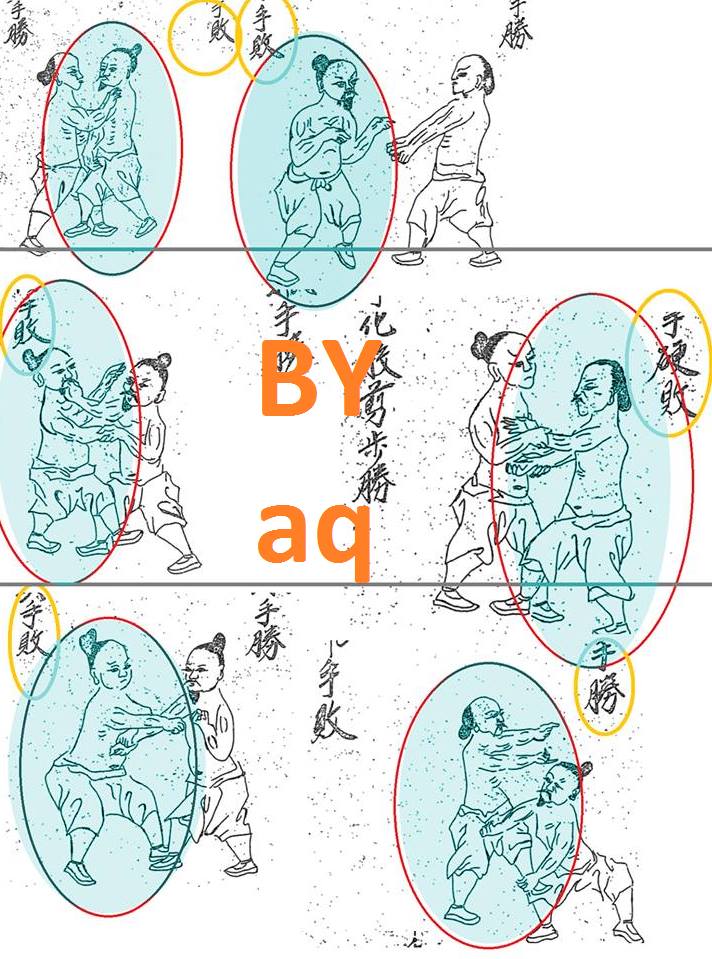Floating Foot is a literal translation of the Japanese word ukiashi 浮き足. It refers to an unsteady step, to standing on the tiptoes, to being ready to flee, and even – figuratively – to high volatility in a financial market. The reason is that one foot is not grounded in the placement. The term ukiashi is famous in Japanese martial arts because it was described by Miyamoto Musashi (1584–1645) as one of “the three footworks to avoid”:
“The method of footwork is to lift your toes a little and strongly step with your heel. Depending on the circumstances, footwork is sometimes large, sometimes small, sometimes slow, and sometimes fast. However: You always use your feet as if you are walking normally. The three things you shall avoid are 1) to step by jumping, 2) to step by letting the feet float (ukiashi 浮足), and 3) to step while your waist is dropped. An important thing taught in the art of war is what is called the ‘Yin and Yang Feet’. This is also very important in this style (Niten Ichi Ryū). The use of the ‘Yin and Yang Feet’ means that you shall not move only one foot. When you cut, or when you draw the sword, or even when you receive [block] a sword, you step right-left-right-left, such as if you are alternating between the two poles of Yin and Yang. Although it seems as if I am repeating myself many times over: Please do not step with only one foot in the center line! I want you to examine this well.” From: Miyamoto Musashi, The Book of Five Rings – The Book of Water, Section 5: The Use of the Feet. (Translation by Andreas Quast).
In Karate, ukiashi has been likened to the so-called cat-foot-stance (nekoashi), which is widely seen in modern Karate. The issue gets apparent in the following words by Motobu Chōki:
“In my Karate, there are no stances such as the cat-foot-stance (nekoashi), the forward-bent-stance (zenkutsu), or the backward-bent-stance (kōkutsu). The so-called cat-foot stance (nekoashi) is an example of the floating foot (ukiashi), which is most disliked in the martial arts. This is because if your body receives a blow, you’re blown down immediately since you lose your balance. Zenkutsu and kōkutsu are also unnatural stances, hindering free work and free movement. The stance in my Karate, during both kata and kumite, with the knees lightly bent such as in Naifanchi, allows to move the feet freely. At the time of offense and defense the knees are tightened and the hips are dropped. No weight is placed on neither the front nor the back, but weight is always distributed evenly on both feet.” From: Nakata Mizuhiko, 1978
Motobu Chōki was a person who actually learned old style Karate from masters such as Matsumura Sōkon and Sakuma Pēchin of Shuri, and Matsumora Kōsaku of Tomari. It has therefore been called into question whether there have been as many cat-foot-stances (nekoashi) in old style Karate as there are today. Instead, it is believed that Itosu Ankō, as is evident in his Pinan series, introduced the frequent use of the cat-foot-stance (nekoashi) and the forward-bent-stance (zenkutsu) and by doing so he established a new mainstream of stances. At least this has to be seriously considered in the pre-Itosu <–> post-Itosu traditions.
We also get more of this idea by looking at the Okinawan Bubishi: Among the 96 paired techniques depicted in it – 48 fighting diagrams, two persons each – many qualify for calling the stance a cat-foot-stance (nekoashi). It is interesting to note that the majority of the techniques using the cat-foot-stance are those designated as “loosing techniques”. It therefore appears as if Chinese unarmed martial arts of the 18th and 19th century did not overly support cat-foot-stance (nekoashi) – or “sitting down in the hip” supported by only one leg for that matter.

Excerpts from the Higa Seiko edition of the Bubishi.
I don’t know about Okinawa at that time but today we can create whatever hypothesis for a combative application of a cat-foot-stance (nekoashi). For example, it protects your groin. Or, it is actually an evasive maneuver. Or, it actually signifies a snapped front-toekick to the short-rib in a 60° angle. Or, it trains your pelvic floor. Or, it looks great. Or, because KARATE!, that’s why! However, none of these add anything to the question whether Itosu introduced the extensive use of (static) cat-foot-stance (nekoashi) or not, and moreover, how much of an impact this may actually had afterwards on traditions almost completely influenced by Itosu (e.g. Kobayashi-ryū), or those influenced in large parts by Itosu (e.g. Shitō-ryū under Mabuni Kenwa), and even traditions not directly influenced by Itosu (e.g. Gōjū-ryū, Uechi-ryū), and finally even traditions of Kobudō.
Note: I have been asked about the source of the above quoted words by Motobu Chōki. As I noted above, these are from Nakata Mizuhiko, 1978. Nakata Mizuhiko was a member of Konishi Yasuhiro’s dōjō, and after he met Motobu Chōki he became a kind of guest student at Motobu Chōki’s dōjō. For example, in 1935, Nakata demonstrated Karate together with Motobu Chōki and Konishi Yasuhiro at the Japanese Ministry of Railways. He wrote down things said by Motobu Chōki which Nakata listened to, or when Nakata inquired about something. So it was a classical “taking notes” thing. These sayings were written down in letters which finally were presented to the Motobu family and compiled in 1978. It was later published in print as “Nakata Mizuhiko: Motobu Chōki Sensei Goroku (Sayings by Motobu Chōki Sensei). 1978, in Konuma Tamotsu (compilation): Motobu Chōki Seiden – Ryūkyū Kenpō Karatejutsu Tatsujin, 1993, and republished under the same name in 2000 (page 79 – 98) (中田瑞彦: 本部朝基先生・語録. In: 小沼保: 本部朝基正伝 琉球拳法空手術達人 ).
© 2017, Andreas Quast. All rights reserved.
